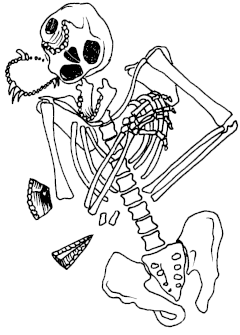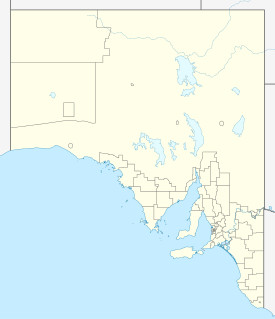
Naracoorte Caves National Park is a national park near Naracoorte in the Limestone Coast tourism region in the south-east of South Australia (Australia). It was officially recognised in 1994 for its extensive fossil record when the site was inscribed on the World Heritage List, along with Riversleigh. The park preserves 6 km2 of remnant vegetation, with 26 caves contained within the 3.05 km2 World Heritage Area. Out of the 28 known caves in the park, only four are open to the public. Other caves are kept away from the public eye as they are important for scientific research and also for the protection of the caves and their contents. Many of the caves contain spectacular stalactites and stalagmites.

Thylacoleo is an extinct genus of carnivorous marsupials that lived in Australia from the late Pliocene to the late Pleistocene. Some of these marsupial lions were the largest mammalian predators in Australia of their time, with Thylacoleo carnifex approaching the weight of a lioness. The estimated average weight for the species ranges from 101 to 130 kg.

Hypsilophodon is an ornithischian dinosaur genus from the Early Cretaceous period of England. It has traditionally been considered an early member of the group Ornithopoda, but recent research has put this into question.

The logrunners (Orthonyx) are a clade of birds which comprises three species of passerine birds endemic to Australia and New Guinea. Some authorities consider the Australian family Cinclosomatidae to be part of the Orthonychidae. The three species use their stiffened tails to brace themselves when feeding.

Kebara Cave is an Israeli limestone cave locality in Wadi Kebara, situated at 60 to 65 m above sea level on the western escarpment of the Carmel Range, in the Ramat HaNadiv preserve of Zichron Yaakov.

The Wellington Caves are a group of limestone caves located 8 kilometres (5.0 mi) south of Wellington, New South Wales, Australia.
Yingshanosaurus is a genus of stegosaurian dinosaur from the Late Jurassic, around 155 million years ago. It was a herbivore that lived in what is now China. The type species is Yingshanosaurus jichuanensis.
Devil's Lair is a single-chamber cave with a floor area of around 200 m2 (2,200 sq ft) that formed in a Quaternary dune limestone of the Leeuwin–Naturaliste Ridge, 5 km (3.1 mi) from the modern coastline of Western Australia. The stratigraphic sequence in the cave floor deposit consists of 660 cm (260 in) of sandy sediments, with more than 100 distinct layers, intercalated with flowstone and other indurated deposits. Excavations have been made in several areas of the cave floor. Since 1973, excavations have been concentrated in the middle of the cave, where 10 trenches have been dug. Archaeological evidence for intermittent human occupation extends down about 350 cm (140 in) to layer 30, with hearths, bone, and stone artefacts found throughout. The site provides evidence of human habitation of Southwest Australia 50,000 years before the present day.

Simosthenurus, also referred to as the short-faced kangaroo, is an extinct genus of megafaunal macropods that existed in Australia, specifically Tasmania, during the Pleistocene. Analysis of Simosthenurus fossils has contributed to the finding that there are three lineages of macropods: Sthenurinae, Macropodinae, and Lagostrophinae. The genus Simosthenurus was among the sthenurines.
Paleontology or palaeontology is the study of prehistoric life forms on Earth through the examination of plant and animal fossils. This includes the study of body fossils, tracks (ichnites), burrows, cast-off parts, fossilised feces (coprolites), palynomorphs and chemical residues. Because humans have encountered fossils for millennia, paleontology has a long history both before and after becoming formalized as a science. This article records significant discoveries and events related to paleontology that occurred or were published in the year 1985.

Makapansgat is an archaeological location within the Makapansgat and Zwartkrans Valleys, northeast of Mokopane in Limpopo province, South Africa. It is an important palaeontological site, with the local limeworks containing Australopithecus-bearing deposits dating to between 3.0 and 2.6 million years BP. The whole Makapan Valley has been declared a South African Heritage Site. Makapansgat belongs to the Cradle of Humankind.

Malapa is a fossil-bearing cave located about 15 kilometres (9.3 mi) northeast of the well known South African hominid-bearing sites of Sterkfontein and Swartkrans and about 45 kilometres (28 mi) north-northwest of Johannesburg, South Africa. It is situated within the Cradle of Humankind World Heritage Site.

Mammoth Cave is a large limestone cave 21 km (13 mi) south of the town of Margaret River in south-western Western Australia, and about 300 km (190 mi) south of Perth. It lies within the Leeuwin-Naturaliste National Park and is surrounded by karri and marri forest. There have been extinct animal fossils found in Mammoth Cave.

Haasgat is a fossiliferous South African paleocave located in the Cradle of Humankind UNESCO World Heritage Area, approx. 20 kilometres (12 mi) northeast of the hominin-bearing sites of Sterkfontein and Swartkrans and approx. 60 kilometres (37 mi) north-northwest of the City of Johannesburg. It is located on private land and is not accessible by the public.
Willi Willi Caves Nature Reserve covers 8 ha and is located on the Mid North Coast of New South Wales on the lower slope of a ridge in the upper Macleay River catchment, 35 km to the west of Kempsey.

Fossil Cave (5L81), formerly known as The Green Waterhole, is a cave in the Limestone Coast region of south-eastern South Australia. It is located in the gazetted locality of Tantanoola about 22 kilometres north-west of the city of Mount Gambier, only a few metres from the Princes Highway between Mount Gambier and Millicent. It is notable both as a paleontological site and as a cave diving site.
Centropus colossus is an extinct species of coucal from the Late Pleistocene of Australia. It was described from submerged subfossil material collected in 1979 from the Fossil Cave in the south-east of South Australia. Characteristics of the holotype specimen indicate that the bird was either flightless or, at least, had reduced flight capability. It was larger than any of its living congeners and was one of the largest cuckoos in the world. The specific epithet, the Latin colossus, refers to its great size.

The Cliefden Caves ia heritage-listed geoheritage site in Mandurama, Cowra Shire, New South Wales, Australia. The caves comprises Ordovician fossil localities, limestone caves, a spring and tufa dams, and a site where limestone was first discovered in inland Australia.

Homo naledi is a species of archaic human discovered in the Rising Star Cave, Cradle of Humankind, South Africa dating to the Middle Pleistocene 335,000–236,000 years ago. The initial discovery comprises 1,550 specimens, representing 737 different elements, and at least 15 different individuals. Despite this exceptionally high number of specimens, their classification with other Homo remains unclear.

Bohra is an extinct genus of macropod from the Plio-Pleistocene of Australia.













